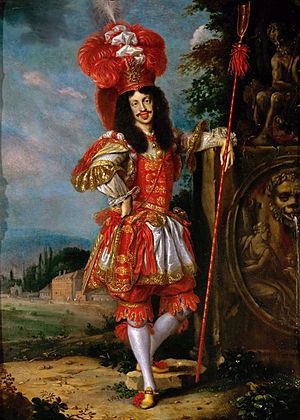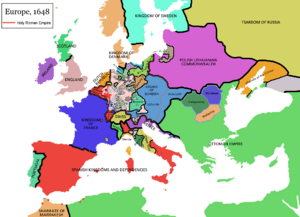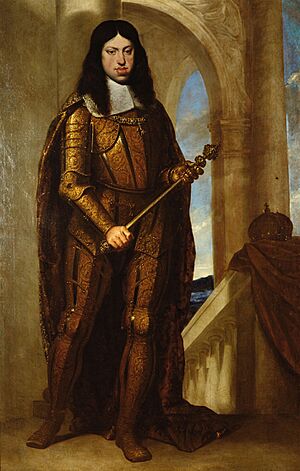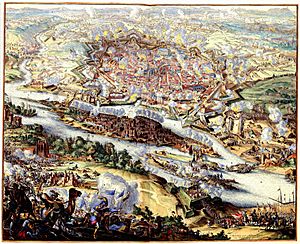Leopold I, Holy Roman Emperor facts for kids
Quick facts for kids Leopold I |
|||||
|---|---|---|---|---|---|

Portrait by Benjamin von Block, 1672
|
|||||
| Holy Roman Emperor (more...) | |||||
| Reign | 18 July 1658 – 5 May 1705 | ||||
| Proclamation | 1 August 1658, Frankfurt | ||||
| Predecessor | Ferdinand III | ||||
| Successor | Joseph I | ||||
| Born | 9 June 1640 Vienna, Austria |
||||
| Died | 5 May 1705 (aged 64) Vienna, Austria |
||||
| Burial | Imperial Crypt | ||||
| Spouse |
|
||||
| Issue Detail |
|
||||
|
|||||
| House | Habsburg | ||||
| Father | Ferdinand III, Holy Roman Emperor | ||||
| Mother | Maria Anna of Spain | ||||
| Religion | Roman Catholicism | ||||
| Signature | |||||
Leopold I (born Leopold Ignaz Joseph Balthasar Franz Felician; June 9, 1640 – May 5, 1705) was a very important ruler in European history. He was the Holy Roman Emperor, and also the King of Hungary, Croatia, and Bohemia.
Leopold became the heir to the throne in 1654 after his older brother, Ferdinand IV, passed away. He was elected Holy Roman Emperor in 1658 and ruled for nearly 47 years until his death in 1705. This made him the second longest-ruling Habsburg emperor. Leopold was also a talented composer and a big supporter of music.
His time as emperor was marked by major wars. He fought against the Ottoman Empire in the Great Turkish War and had a long rivalry with Louis XIV of France. Leopold won against the Ottomans, thanks to military leaders like Prince Eugene of Savoy. This victory helped him regain much of Hungary.
Leopold also fought three wars against France. These included the Franco-Dutch War, the Nine Years' War, and the War of the Spanish Succession. He wanted his younger son, Charles, to inherit the Spanish throne. The war continued even after Leopold's death.
Contents
Leopold I: Holy Roman Emperor
Early Life and Education
Leopold was born in Vienna on June 9, 1640. He received a broad education, learning about history, literature, science, and astronomy. He especially loved music, just like his father, Emperor Ferdinand III.
He was very good at languages, speaking Latin, Italian, German, French, and Spanish. Italian became a very popular language at his court.
Leopold was first trained to become a priest. This plan changed when his older brother died in 1654, making Leopold the next in line for the throne. However, his religious education deeply influenced him. He remained very religious and knowledgeable about theology and sciences throughout his life. He also kept his interest in astrology and alchemy.
People described Leopold as quiet and serious in public. But he was open and friendly with his close friends. He was known for having the typical Habsburg jaw.
Becoming Emperor
Leopold was elected King of Hungary in 1655, and then of Bohemia and Croatia in the following years. In July 1658, he was elected Holy Roman Emperor in Frankfurt. This happened despite efforts by France to put another prince on the throne.
To keep France happy, Leopold promised not to help Spain, which was at war with France. This started a nearly 47-year rivalry with Louis XIV. Even though Leopold didn't lead his armies in person like Louis XIV, he was still a strong leader who focused on wars.
Wars and Challenges
Fighting the Ottoman Empire
The Ottoman Empire often interfered in Transylvania, a region that was part of Leopold's lands. This led to a war in 1663. Leopold convinced German princes to send help, and France also sent troops. In August 1664, the Imperial general Raimondo Montecuccoli won a big victory at Saint Gotthard.
Later, in 1683, the Ottomans sent a huge army to Austria and besieged Vienna. Leopold had to flee. But German princes and the King of Poland, John III Sobieski, came to help.
On September 12, 1683, the allied army defeated the Ottomans, saving Vienna. Imperial forces, including the rising star Prince Eugene of Savoy, continued to win battles. In 1699, the Ottomans signed the Treaty of Karlowitz. This treaty gave almost all of Hungary back to the Habsburgs.
Before the war ended, Leopold made changes to strengthen his control over Hungary. In 1687, the Hungarian diet (assembly) agreed that the Habsburgs would inherit the throne without an election. Leopold's son, Joseph I, was crowned hereditary King of Hungary.
Conflicts with France
France's power grew and threatened the Holy Roman Empire. This led to the Franco-Dutch War in 1672. Leopold formed an alliance with other European powers against France. The war ended with the Treaty of Nijmegen in 1678.
Soon after, France continued to expand its territory. Leopold joined the League of Augsburg in 1686 to protect the peace treaties. In 1689, a larger group called the Grand Alliance was formed against France. This alliance included the emperor, England, Spain, and Denmark.
The wars against France were long and difficult. The Treaty of Rijswijk in 1697 brought some peace. However, Europe was soon involved in the War of the Spanish Succession. The King of Spain, Charles II, had no children. Leopold wanted his son, Charles, to inherit the Spanish throne.
When Charles II died in 1700, he left his crown to a grandson of Louis XIV of France. This led to a new war. Leopold was a key member of a renewed Grand Alliance against France. The war started well for Austria, with victories at Schellenberg and Blenheim. Leopold died in 1705, but the war continued until 1714.
Internal Challenges and Reforms
Leopold faced challenges within his own lands, especially in Hungary. There was unrest partly because he wanted to reduce the influence of Protestantism. A revolt was put down in 1671, and Hungary was treated harshly for some years. Later, some changes were made to ease tensions.
Leopold also expelled Jewish communities from his lands, including from Vienna. The area where the Viennese Jewish community lived was renamed Leopoldstadt in his honor.
Changes in the Empire
The Peace of Westphalia in 1648 had weakened the Holy Roman Emperor's power. However, it also strengthened the Habsburgs' control over their own lands like Bohemia and Austria. Leopold was one of the first emperors to understand this change.
In 1663, the Imperial Diet (a kind of parliament) became a permanent meeting in Regensburg. This helped Leopold to strengthen Habsburg power.
In 1692, the Duke of Hanover became an elector, joining the group of princes who elected the emperor. In 1700, Leopold granted the title of King in Prussia to the Elector of Brandenburg. These changes meant the emperor had less direct power over the other German states. He had to rely more on his power as ruler of Austria, Hungary, and Bohemia.
Character and Legacy
Leopold was a hardworking and educated ruler. He believed he was an absolute ruler and held strongly to his rights. He was deeply influenced by the Jesuits and strongly supported the Counter-Reformation.
He was short but strong and enjoyed outdoor activities like hunting and riding. He also loved music and composed several oratorios and dance suites.
Family Life


Leopold married three times and had many children.
His first wife was Margaret Theresa of Spain (1651–1673). She was his niece and first cousin. They had four children:
- Archduke Ferdinand Wenzel (1667–1668)
- Archduchess Maria Antonia (1669–1692)
- Archduke Johann Leopold (1670)
- Archduchess Maria Anna Antonia (1672)
His second wife was Claudia Felicitas of Austria. She passed away in 1676 at a young age. Their two daughters did not survive:
- Archduchess Anna Maria Josepha (1674)
- Archduchess Maria Josepha Clementina (1675–1676)
His third wife was Eleonor Magdalene of Neuburg. They had many children who survived:
- Joseph I, Holy Roman Emperor (1678–1711)
- Archduchess Maria Christina (1679)
- Archduchess Maria Elisabeth (1680–1741)
- Archduke Leopold Joseph (1682–1684)
- Archduchess Maria Anna (1683–1754)
- Archduchess Maria Theresa (1684–1696)
- Charles VI, Holy Roman Emperor (1685–1740)
- Archduchess Maria Josepha (1687–1703)
- Archduchess Maria Magdalena (1689–1743)
- Archduchess Maria Margaret (1690–1691)
Music and Arts
Leopold was a great supporter of music and a composer himself. He brought many famous composers to his court, such as Antonio Bertali and Johann Fux. He helped make the court's musical life very rich.
His own music includes oratorios and dramatic works. His religious music is especially well-known, like a Requiem Mass he wrote for his first wife. Many of Leopold's musical works were published with his father's compositions.
Images for kids
-
Hungarian Thaler of Leopold I minted in 1692. Latin inscription: Obverse, LEOPOLDVS D[EI] G[RATIA] RO[MANORVM] I[MPERATOR] S[EMPER] AVG[VSTVS] GER[MANIAE] HV[NGARIAE] BO[HEMIAE] REX; Reverse, ARCHIDVX AVS[TRIAE] DVX BVR[GVNDIAE] MAR[CHIO] MOR[AVIAE] CO[MES] TY[ROLIS] 1692, "Leopold, by the grace of God, Emperor of the Romans, Ever Augustus, King of Germany, Hungary, and Bohemia; Archduke of Austria, Duke of Burgundy, Margrave of Moravia, Count of Tyrol 1692"
-
Silver coin of Leopold I, 3 Kreuzer, dated 1670. The Latin inscription reads (obverse): LEOPOLDVS D[EI] G[RATIA] R[OMANORVM] I[MPERATOR] S[EMPER] A[VGVSTVS] G[ERMANIAE] H[VNGARIAE] B[OHEMIAE] REX (reverse):ARCHID[VX] AVS[TRIAE] DVX B[VRGVNDIAE] CO[MES] TYR[OLIS] 1670. In English: "Leopold, by the Grace of God, Emperor of the Romans, always August, King of Germany, Hungary, and Bohemia, Archduke of Austria, Duke of Burgundy, Count of Tyrol, 1670."
See also
 In Spanish: Leopoldo I del Sacro Imperio Romano Germánico para niños
In Spanish: Leopoldo I del Sacro Imperio Romano Germánico para niños
- Academy of Sciences Leopoldina
- Family tree of the German monarchs







